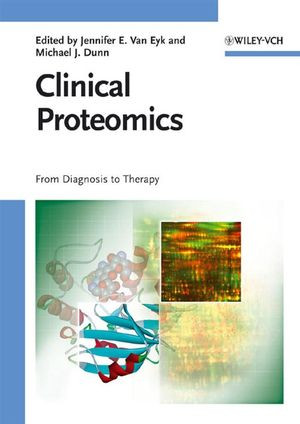Product desciption
Clinical Proteomics From Diagnosis To Therapy Jennifer E Van Eyk by Jennifer E. Van Eyk, Michael J. Dunn 9783527316373, 9783527622153, 352731637X, 3527622152 instant download after payment.
Unparalleled in its scope and depth, this book brings together proteomic approaches in diagnosis and treatment from all clinical fields, including clinical toxicology. The result is a new discipline in molecular medicine that will revolutionize the treatment and prevention of cancer, stroke and other severe diseases.
Following an overview of clinical proteomics, the authors look at the technologies available, before moving on to cancer, cardiopulmonary disease, diabetes and stroke. A whole section is devoted to toxicity and the work is rounded off with a discussion of the future of clinical proteomics.Content:
Chapter 1 Preanalytical Issues in Clinical Proteomic Studies (pages 1–12): Roisean E. Ferguson and Rosamonde E. Banks
Chapter 2 Protein Separation by Two?Dimensional Electrophoresis (pages 13–29): Pamela M. Donoghue, Miroslava Stastna and Prof. Dr. Michael J. Dunn
Chapter 3 Protein Separation: Liquid Chromatography (pages 31–51): Miroslava Stastna and Dr. Jennifer Van Eyk
Chapter 4 HPLC in Protein Discovery (pages 53–60): Timothy J. Barder
Chapter 5 IEF Analysis of Peptides for Biomarkers Discovery (pages 61–71): Ali R. Vaezzadeh, Catherine G. Zimmermann?Ivol, Jacques Deshusses, Alexander Scherl and Denis F. Hochstrasser
Chapter 6 Capillary Electrophoretic Separations for Clinical Proteomics (pages 73–88): Brian M. Balgley, Weijie Wang, Xueping Fang, Don L. DeVoe and Cheng S. Lee
Chapter 7 Quantitative Proteomics Using Nano?LC with High Accuracy Mass Spectrometry (pages 89–100): Ljiljana Pasa?Tolic, Jon M. Jacobs, Wei?Jun Qian and Richard D. Smith
Chapter 8 Antibody Microarrays for Protein and Glycan Detection (pages 101–111): Songming Chen and Brian B. Haab
Chapter 9 Biomarker Identification: The Role of Experimental Design, Statistics, and Data Sharing (pages 113–120): Marc R. Wilkins
Chapter 10 Applications of Stable Isotope Tagging Based Quantitative Proteomics in Cancer Research (pages 121–143): Ru Chen, Teresa A. Brentnall and Ruedi Aebersold
Chapter 11 Two?Dimensional Liquid Separations, Protein Microarrays, and Mass Spectrometry in Comprehensive Analysis of Posttranslational Modifications and Biomarker Discovery in Cancers (pages 145–164): Tasneem H. Patwa, Jia Zhao, David E. Misek and David M. Lubman
Chapter 12 Development and Use of Reversed?Phase Protein Microarrays for Clinical Applications (pages 165–175): Virginia Espina, Julia Wulfkuhle, Valerie S. Calvert, Kirsten H. Edmiston, Lance A. Liotta and Emanuel F. Petricoin
Chapter 13 Cyclin?Dependent Kinase Inhibitors and Cancer: Usefulness of Proteomic Approaches in Assessment of the Molecular Mechanisms and Efficacy of Novel Therapeutics (pages 177–202): Marian Hajduch, Helena Skalnikova, Petr Halada, David Vydra, Petr Dzubak, Marta Dziechciarkova, Miroslav Strnad, Danuta Radioch, Suresh Jivan Gadher and Hana Kovarova
Chapter 14 Diagnostic Markers for Monitoring Heart Transplant Rejection (pages 203–215): Dr. Ciara A. McManus, Professor Marlene L. Rose and Prof. Dr. Michael J. Dunn
Chapter 15 The Study of Microheterogeneity in Human Plasma Proteins: Application to Acute Myocardial Infarction (pages 217–229): Randall W. Nelson, Urban A. Kiernan, Dobrin Nedelkov, Kemmons A. Tubbs and Eric E. Niederkofler
Chapter 16 Discovery of Biomarkers for Cardiovascular Diseases (pages 231–240): Anthony O. Gramolini and Andrew Emili
Chapter 17 Development of Biomarker Development Pipeline: Search for Myocardial Ischemia Biomarkers (pages 241–261): Qin Fu, Shijun Sheng and Dr. Jennifer E. Van Eyk
Chapter 18 The Albuminome as a Tool for Biomarker Discovery (pages 263–278): Rebekah L. Gundry and Robert J. Cotter
Chapter 19 Application of Metabolomics to Cardiovascular Biomarker and Pathway Discovery (pages 279–293): Gregory D. Lewis and Robert E. Gerszten
Chapter 20 Urinary Biomarkers in Diabetic Nephropathy and Other Glomerular Diseases (pages 295–322): John M. Arthur and T. Brian Powell
Chapter 21 Pulmonary Proteomics (pages 323–347): Jan Hirsch, Lorraine B. Ware and Michael A. Matthay
Chapter 22 Proteomics Providing Insights into Major Psychiatric Disorders (pages 349–377): Melanie Focking, Kyla Pennington, Jane English, Prof. Dr. Michael Dunn and David Cotter
Chapter 23 Redox Proteomics Analysis of Oxidative Modified Brain Proteins in Alzheimer's Disease and Mild Cognitive Impairment: Insights into the Progression of This Dementing Disorder (pages 379–401): Rukhsana Sultana and D. Allan Butterfield
Chapter 24 Toxicoproteomics: Correlating Tissue and Serum Proteomics in Liver Injury (pages 403–433): B. Alex Merrick
Chapter 25 Biomarkers for Renal Disease and Uremic Toxins (pages 435–452): Eric Schiffer, Harald Mischak and Raymond C. Vanholder
Chapter 26 HIV and Other Viral Screens (pages 453–480): David R. Graham
Chapter 27 Application of Fungal Cyclic Peptides and Metabolites (pages 481–509): Jan Nedved, Miroslav Sulc, Alexandr Jegorov, Anastassios Giannakopulos and Vladimir Havlicek
Chapter 28 Microarray Approaches to Autoantibody Profiling (pages 511–532): John M. Astle and Thomas Kodadek
Chapter 29 Identification of Tumor Antigen Directed Autoantibodies (pages 533–547): Sandra Faca and Sam Hanash
Chapter 30 Antibody and Reverse Capture Protein Microarrays for Clinical Proteomics (pages 549–569): Harvey B. Pollard, Ofer Eidelman, Meera Srivastava, Catherine Joswik, Stephen Rothwell, Gregory P. Mueller, David M. Jacobowitz, William B. Guggino, Jerry Wright, Pamela L. Zeitlin and Cloud P. Paweletz
Chapter 31 Use of Antibody Microarrays in the Analysis of Inflammation, Autoimmunity, Viral Infection, and Cancer Metastases (pages 571–592): Rodney Lui, Angus Brown, Bosco Wu, Ming?Wei Lin, John Thompson, Filip Braet, Wayne Dyer, JoDee Lattimore, Peter Macdonald, Stephen Adelstein and Cristobal G. dos Remedios
Chapter 32 The Future: Translation from Discovery to the Clinic – Roles of HUPO and Industry in Biomarker Discovery (pages 593–613): Gilbert S. Omenn and Peipei Ping
Chapter 33 Requirements of a Good Biomarker: Translation into the Clinical Laboratory (pages 615–631): Mario Plebani, Martina Zaninotto and Monica Maria Mion
Chapter 34 Translation of Protein Biomarkers for Clinical Development (pages 633–651): Ian McCaffery, V. Dan Fitzpatrick, Shen Wu Wang, John M. Rossi, Haifeng Bao, Sid V. Suggs, John Ferbas and Scott D. Patterson


